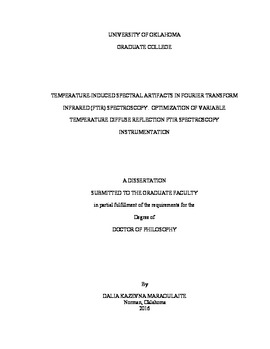| dc.contributor.advisor | White, Robert | |
| dc.contributor.author | Maraoulaite, Dalia | |
| dc.date.accessioned | 2016-12-19T15:24:07Z | |
| dc.date.available | 2016-12-19T15:24:07Z | |
| dc.date.issued | 2016-12-16 | |
| dc.identifier.uri | https://hdl.handle.net/11244/47091 | |
| dc.description.abstract | High stability Fourier transform infrared (FT-IR) interferometers make it possible to conduct experiments designed to identify subtle sample structure changes resulting from external perturbations. In particular, variable temperature diffuse reflection infrared Fourier transform spectroscopy (VT-DRIFTS) can be used to associate specific structure changes with incremental additions of thermal energy by observing the sample in-situ while heating, eliminating the need for separate measurements that can introduce error. This fast, low cost spectroscopic technique requires a small sample and little preparation, but is complicated by the fact that when the sample is heated, the system is also perturbed rendering the data difficult to interpret due to so-called “thermal artifacts.” Until now little has been done to understand the effect of thermal fluctuations on IR spectra due to instrument response. In this study a thorough characterization of the VT-DRIFTS system led to the identification of the key sources of spectral changes, minimization of thermal artifacts, and development of a data processing method. Experimental studies have shown that the main causes of temperature-induced artifacts are thermal expansion-related alignment changes in the optical transmission system, especially near the sample holder and the interferometer, and modulated and unmodulated thermal emission from the sample itself and instrument components, which affect the detector response at high temperatures. Incorporating thermal barriers and redesigning the sample holder to incorporate quartz has decreased temperature-induced alignment changes. Incorporating cube-corner mirrors at the interferometer and blocking 1/2 the IR beam between the interferometer and the sample solves the modulated thermal emission problem by the method of destructive interference of the noise waives. Unmodulated emission can be accounted for by scaling the data post-collection using computational macros. Thus, the effects of temperature on IR spectra have been characterized, and solutions have been proposed for variable temperature instrument optimization. Capabilities of the VT-DRIFTS methodology are demonstrated in this work. | en_US |
| dc.language | en_US | en_US |
| dc.subject | VT-DRIFTS | en_US |
| dc.subject | diffuse reflectance infrared spectroscopy | en_US |
| dc.subject | infrared thermal analysis | en_US |
| dc.subject | temperature-induced spectral artifacts | en_US |
| dc.title | TEMPERATURE-INDUCED SPECTRAL ARTIFACTS IN FOURIER TRANSFORM INFRARED (FTIR) SPECTROSCOPY. OPTIMIZATION OF VARIABLE TEMPERATURE DIFFUSE REFLECTION FTIR SPECTROSCOPY INSTRUMENTATION | en_US |
| dc.contributor.committeeMember | Yip, Wai Tak | |
| dc.contributor.committeeMember | Liu, Shaorong | |
| dc.contributor.committeeMember | Rice, Charles | |
| dc.contributor.committeeMember | Nanny, Mark | |
| dc.date.manuscript | 2016-12-16 | |
| dc.thesis.degree | Ph.D. | en_US |
| ou.group | College of Arts and Sciences::Department of Chemistry and Biochemistry | en_US |
| shareok.orcid | 0000-0002-0542-3841 | en_US |
